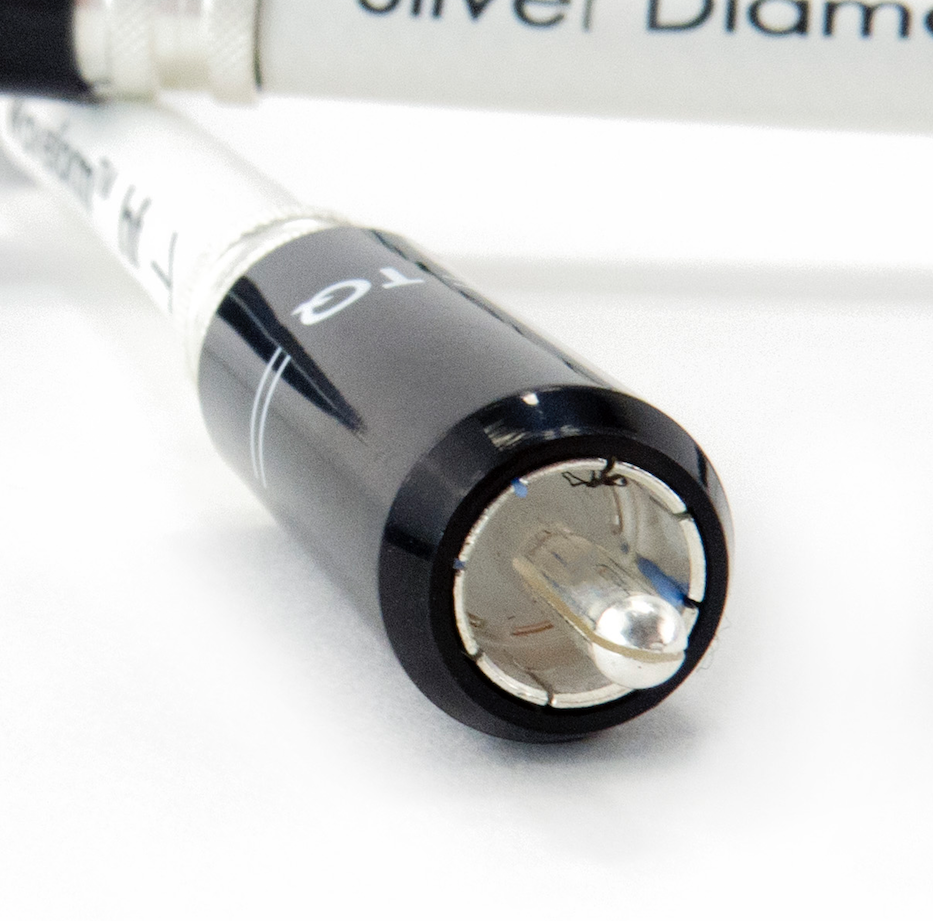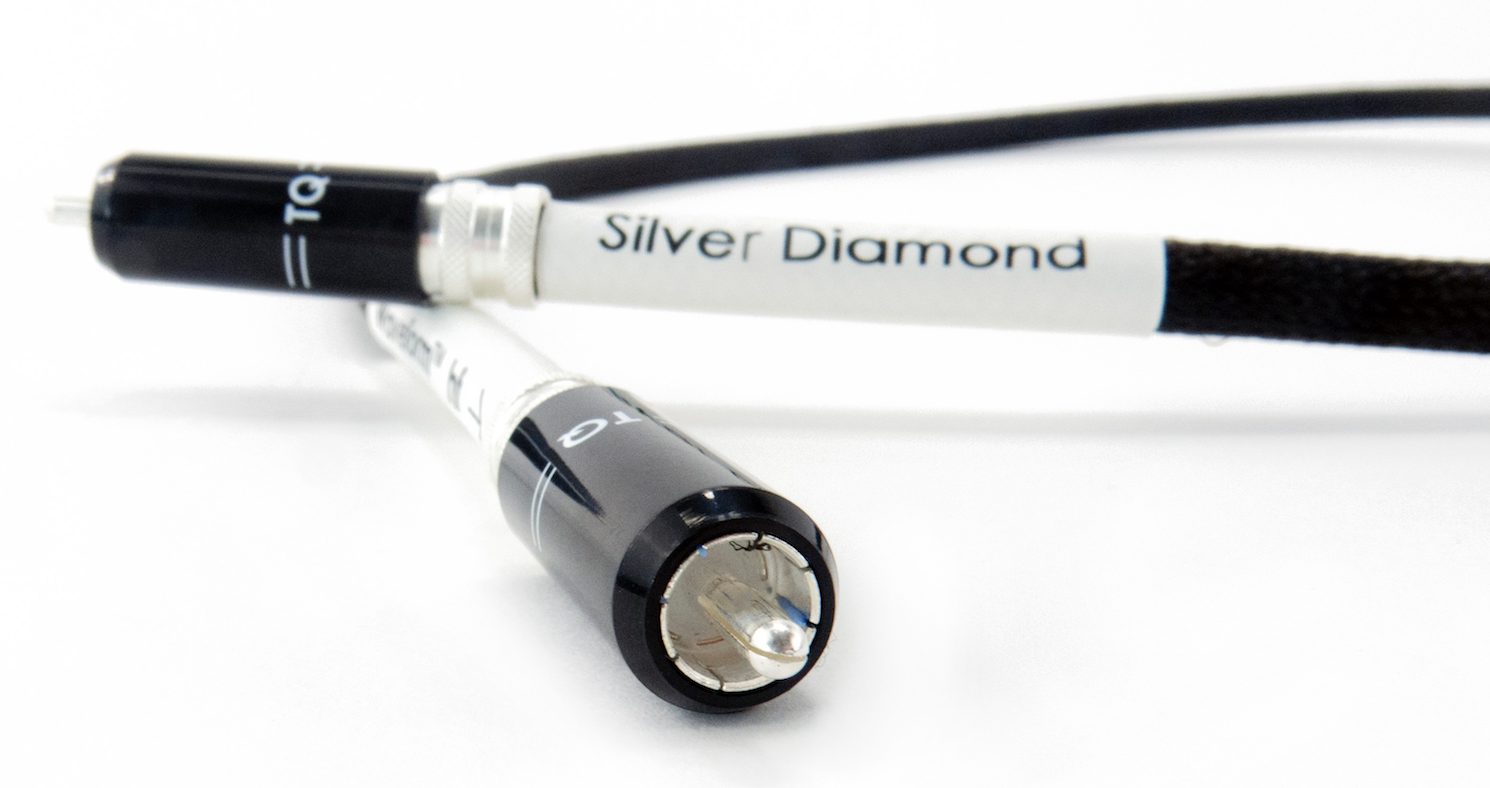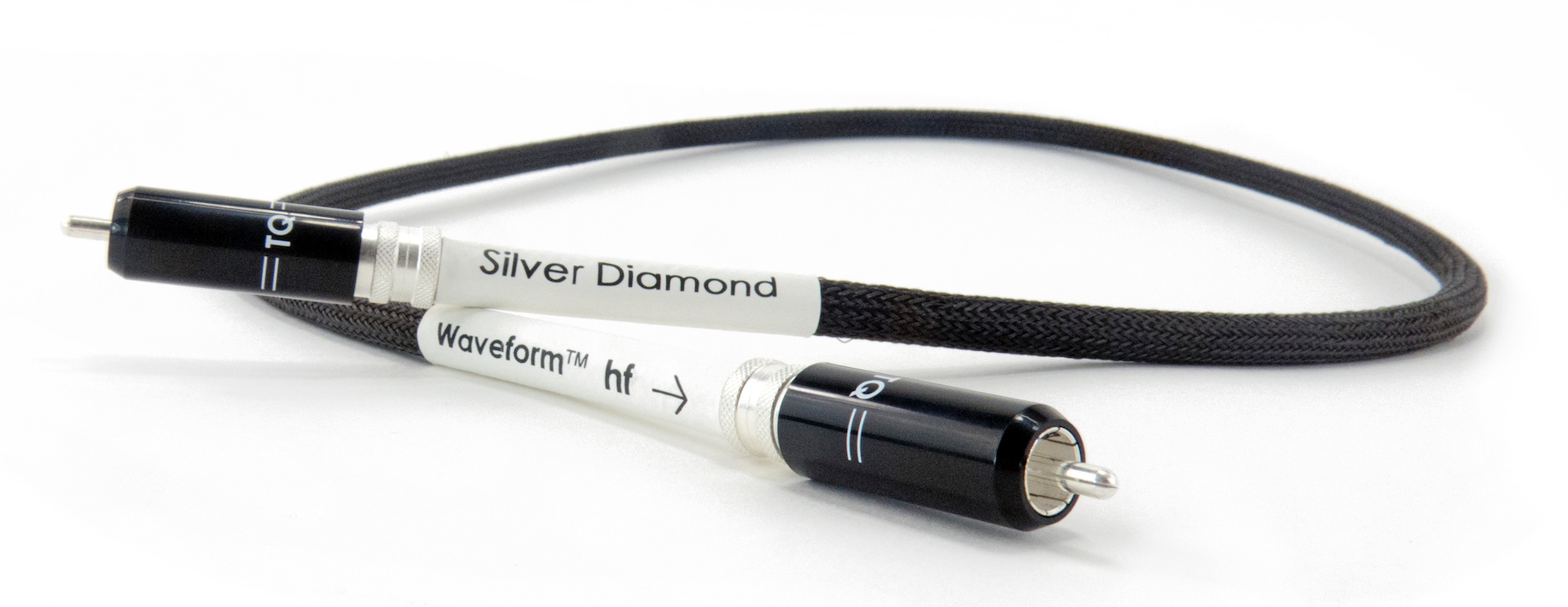The Article
Silver Diamond Waveform hf Digital RCA: High-End Bits
24th November 2017

Looking beyond pure ones and zeroes, Paul Rigby seeks digital perfection as he reviews Tellurium Q’s Silver Diamond Waveform hf Digital RCA
Apart from plugging one box to another box or the mains to lots of boxes, one of the biggest jobs any cable can do is to become invisible. The problem with cheap cables is that they tend not to be. There’s all kinds of reasons for that which would take a few thousand words to explain fully. Suffice to say, in addition to the rest of your hi-fi and the room it sits within, your cables will add a little bit of noise here and there to the hi-fi and, hence, your music. The better they are, the less noise they introduce. The better they are, the more transparency they introduce. Basically, the better they are, the more music you hear. Music that’s always been there, by the way. It’s just that noise masks it.
Don’t confuse price with ‘better’, either. I’ve heard many (too many) cables that cost an arm and a leg but add a suite of horrendous frequencies into the soundstage, adding terrible colouring to the music itself.
A sense of transparency what what I was looking for from the Tellurium Q cable here. I’ve already reviewed it’s sister cable, the Waveform II HERE. This cable, with the rather shy lower case appellation ‘hf’, is an upgrade from that.
Like all TQ cables, there’s not a great deal to talk about because, well, the company doesn’t. TQ likes to keep quiet about its technologies, therefore.
So, what does it sound like?
SOUND QUALITY
I began by hooking my Leema Antila IIS Eco CD player (as a transport) to my Benchmark DAC and played Depeche Mode’s Enjoy the Silence.
Three things struck me with the Waveform hf cable. Firstly was the reduction in noise. That reduction removed the irritating, distortive effects that make the ear cringe and withdraw. Hence, the noise reduction gave the impression that the volume had decreased. This necessitated a rise in gain via my pre-amp by two clicks to attain the same volume as before.
Next was the concurrent smoothness from the mids, especially the upper midrange. All of the synth lines flowed while the lead vocal from David Gahan eased into the song. His, now more relaxed, delivery also offered great emotion and a presentation which added subtlety and a sense that he was enjoying himself.
Thirdly, was the bass. My goodness the lower frequencies added power to burn. Not so much in terms of punch just a hefty weight, a real force of nature. The bass controlled the foundation of this song, giving it an incredible momentum that was elemental in its authority. Impressed, I felt that I’d received a left hook from a heavyweight boxer. One second I’m standing up, the next I’m flat on my back and I had no idea what happened in the middle bit: that sort of effect.
The transient attack from the guitar plucks displayed an impressive focus and precision while the instrumental separation, enhanced by the low noise, allowed the ear to pick up secondary rhythms that occurred way off into the rear of the mix. Previously merged into one, these rhythms could not be picked up and followed independently. Similarly, background vocals were picked out as separate items being joined to the lead vocal but adding enough space to be isolated by the ear too.
I then moved to jazz and Mel Torme with George Shearing. He sang Born to be Blue, a live cut. I was impressed by the nature of the vocal delivery. Live albums are notorious by their decidedly un-audiophile nature. They offer the worst of sonic solutions. Even the best recorded live album is an unhappy compromise. Here, though, the vocal was clear with a sense of transparency that aided the ease of the Torme tone. The sense of live space was also noticeable here. You could hear the air around the Torme vocal.
The accompanying Shearing piano, an instrument that is tremendously difficult for any hi-fi to ‘do well’ due to the chaotic nature of the piano itself in tonal terms, offered a sense of balance and control that was a pleasure to hear on a live disc.
More than that, the upright bass was never wholly lost. The latter can often bloom into a cloudy boom in a live setting but the Waveform hf cable managed to hang on in there, allowing the bass cabinet to give enough resonance to retain a sense of bass personality.
CONCLUSION
The basis for the top notch performance from this cable is the reduction of noise. Noise to hi-fi is like Moriarty to Sherlock Holmes: a nemesis that threatens to destroy all it touches. The lowering noise allows the music that is already there to emerge and light the ear. The TQ Waveform hf cable is able to do that well and successfully producing, ultimately, a superb final sound that delights in terms of detail and power.
SILVER DIAMOND WAVEFORM HF DIGITAL RCA
Price: £1,200 for 1m
Website: www.telluriumq.com
Tel: 01458 251997
GOOD: impressive bass power, low noise, midrange detail, airy soundstage, instrumental separation
BAD: nothing
RATING: 9
REFERENCE SYSTEM
Leema Antilla IIS Eco CD Player
Aesthetix Calypso pre-amp
Icon Audio MB845 Mk.II monoblock amplifiers
Quad ESL-57 speakers with One Thing upgrade
Vertex AQ & Tellurium Q cables
Blue Horizon Professional Rack System
Harmonic Resolution Systems Noise Reduction Components
All vinyl was cleaned using an Audio Desk’s Ultrasonic Pro Vinyl Cleaner








Is that the benchmark dac 1,2 or 3? Just curious.
Hi Geoffrey – it’s this one: https://theaudiophileman.com/benchmark-dac2-hoc-dac-bac/
Paul: At L$1,200/m, a digital cable must transform one’s system into a holographic ‘time-machine’, and not simply lower the noise floor. At that price point, sound quality must be, it should be, that dramatic (holographic), that superb.
I say this because I recently purchased a 1.5m Audioquest ‘Carbon’ coaxial digital cable (approx. $240. CA$) that transformed my system into OMG dimensional realism -while sounding accurate, fast, detailed, nuanced, layered and textured. I thought for sure that AQ must have (by mistake) given me the ‘Diamond’ cable -sans Dielectric ‘box’.
The SQ impressions were nothing short of staggering.
(Just a reminder, that’s $250. CA$, compared to the LBP$1,200/1m (is that about $1,500-$1,800. CA$? per meter. And a 1.5m price ?).
peter jasz
Hi Peter – glad to hear that you’re enjoying your Audioquest. They’re good guys, very enthusiastic and do a good job. In terms of the TQ cables? It depends on your system and how far you’re pushing your sonic level. The better the system, the more detail, insight, clarity, etc, you (should) get. The difference between a ¬£1,000 system and a ¬£5,000 system and a 10k, 40k, etc, ‘should’ be large. The greater the delicacy, the fragility, etc. Hence, even small levels of noise on an expensive system – even on a well treated system – will interfere (this is where the TQ would be of use, that same cable will largely be wasted on a lower cost chain). Hence, higher end ancillaries will go that extra mile. You’re doing the right thing, though. To have the right level of ancillary with the chain you’re running.
Hi Paul: Thanks for the reply. You have no idea what “chain” I’m running.
(RE:” .. You‚Äôre doing the right thing, though. To have the right level of ancillary with the chain you‚Äôre running”)
To suggest a $200 (or $100) cable cannot be used (or in fact out-perform) far more costly cabling is both unwise -and untrue. You yourself recently commented (correctly): ” Don’t equate high price with high performance …” as you rightfully, honestly noted that such (pricey) cables destroy SQ (sound quality).
In any case, a competently engineered cable (i.e. expensive) will and does greatly outperform lesser designs (material/construction quality). Only when experienced, time and time again can the high price of these cables be justified -for indeed, SQ can be elevated to remarkable new heights of realism and involvement -musical expression like none other. Such cables are both pricey, and few and far between.
I must note you (and many others) reach to the same guess, namely : “… The basis for the top notch performance from this cable is the reduction of noise”.
How do you know this ? Everyone speaks of “lowering noise” as the ‘must-be’ reason for enhanced performance/SQ. It’s both unwise and inaccurate to assume “noise-reduction” (in cabling) is the reason -unless one wishes to reveal what type of noise is being addressed, it’s impact upon the signal and to what extent it has been reduced.
There are numerous interactions involved (in cable design) that influence SQ far more than simply dropping HF noise a few db.
peter jasz
Hi Peter – I don’t just review a cable based upon noise but noise is a big deal. There is never one type of noise that is being addressed. Hifi is always under attack from a gamut of noise variants. Always. Hifi kit always has to look at the lot within its design. And yes, if you don’t tackle noise, you only hear 60-70% of the product. No matter how well it might be designed. No matter how much it costs. I know the difference through 30 years of journalistic experience, a good pair of ears and time. I spend an entire day reviewing each and every product (not half an hour as I’ve heard others devote – an entire day – so I compare and contrast, over and over, etc). There are good and bad cable designs out there and there are good and bad speakers out there, etc. Price is irrelevant.